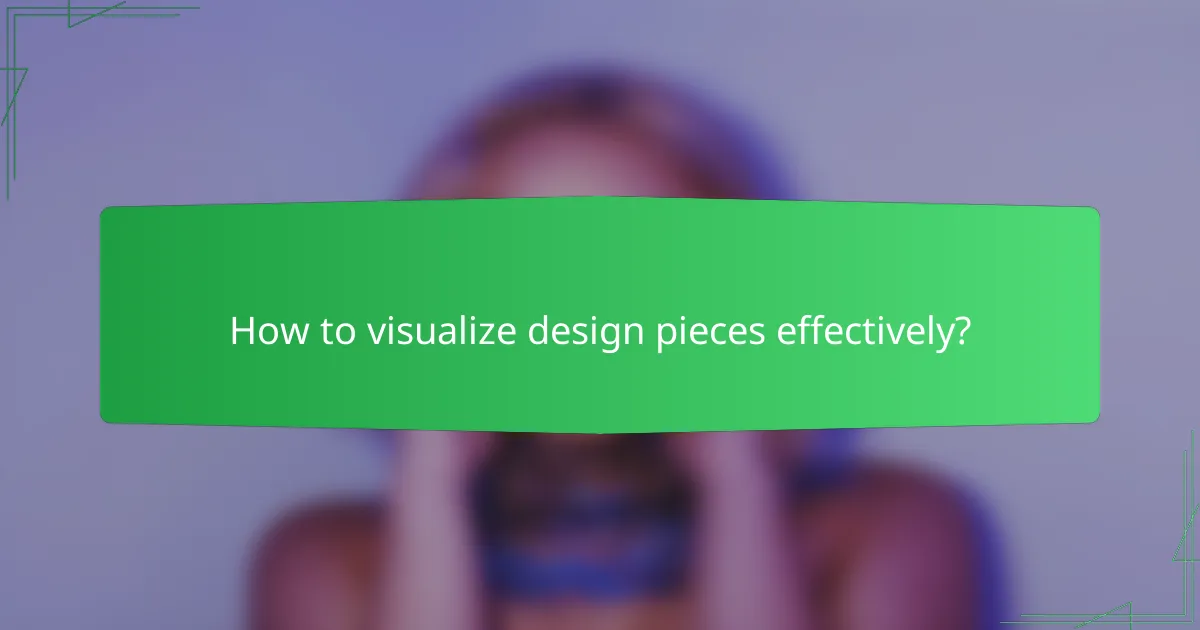Design sketching is a vital process that allows creators to conceptualize ideas and draft plans effectively. By utilizing a variety of tools and techniques, designers can visualize their concepts and refine their vision, ensuring clarity and coherence in their work. From traditional sketching to advanced digital modeling, each method plays a crucial role in bringing innovative ideas to life.

How to effectively conceptualize design sketches in the UK?
To effectively conceptualize design sketches in the UK, start by clearly defining your ideas and objectives. Utilize various techniques and tools to enhance creativity and streamline the drafting process, ensuring your concepts are visually communicated and refined.
Use brainstorming techniques
Brainstorming is a powerful method for generating ideas quickly. Gather a group or work individually to jot down all thoughts related to your design project, regardless of feasibility. This free-flowing approach can lead to unexpected insights and innovative concepts.
Consider using techniques like rapid ideation, where you set a timer and write as many ideas as possible in that period. This can help overcome mental blocks and encourage a diverse range of ideas.
Incorporate mind mapping
Mind mapping visually organizes thoughts and concepts, making it easier to see connections between ideas. Start with a central theme and branch out with related concepts, using keywords and images to enhance understanding.
This technique helps in structuring your thoughts and can serve as a guide when developing your design sketches. Tools like paper, whiteboards, or digital mind mapping software can be effective for this process.
Utilize sketching software like Procreate
Sketching software such as Procreate offers a versatile platform for creating digital designs. It allows for easy adjustments, layering, and the use of various brushes and tools that can enhance your sketches.
Familiarize yourself with the software’s features to maximize your efficiency. For instance, using layers can help separate different elements of your design, making it easier to modify specific parts without affecting the whole sketch.
Engage in collaborative workshops
Collaborative workshops can significantly enhance the conceptualization process by bringing together diverse perspectives. In the UK, consider organizing sessions with fellow designers or stakeholders to share ideas and critique each other’s work.
These workshops can foster creativity and lead to more refined concepts. Ensure to set clear objectives for each session to keep discussions focused and productive.
Study existing designs for inspiration
Analyzing existing designs can provide valuable insights and inspiration for your own sketches. Look at both contemporary and historical designs to understand different styles, techniques, and trends.
Consider creating a mood board that compiles elements from various sources, such as magazines, websites, or design exhibitions. This visual reference can guide your creative process and help you identify what resonates with your vision.

What tools are essential for drafting design plans?
Essential tools for drafting design plans include digital tablets, sketching apps, traditional sketching tools, and 3D modeling software. Each tool serves a unique purpose in the design process, enabling designers to conceptualize, visualize, and refine their ideas effectively.
Digital tablets such as Wacom Cintiq
Digital tablets like the Wacom Cintiq provide a versatile platform for drafting design plans. They allow for direct drawing on the screen, which closely mimics traditional sketching while offering the benefits of digital editing and layering.
When choosing a digital tablet, consider factors such as screen size, pressure sensitivity, and compatibility with design software. A larger screen can enhance visibility, while higher pressure sensitivity allows for more nuanced strokes.
Sketching apps like Adobe Fresco
Sketching apps such as Adobe Fresco are designed to complement digital tablets, offering a range of brushes and tools for creating detailed designs. These apps often include features like cloud storage and collaboration options, making it easier to share work with clients or team members.
Look for apps that support vector and raster graphics, as this versatility can be beneficial for different design tasks. Familiarizing yourself with the app’s interface and tools can significantly improve your workflow.
Traditional tools: pencils, markers, and sketchbooks
Traditional sketching tools, including pencils, markers, and sketchbooks, remain vital for many designers. They provide a tactile experience that can stimulate creativity and allow for quick idea generation without the distractions of digital devices.
When using traditional tools, consider keeping a variety of pencil grades and marker types on hand. This diversity enables you to experiment with different styles and techniques, enhancing your overall design process.
3D modeling software like SketchUp
3D modeling software such as SketchUp is essential for creating detailed and accurate representations of design plans. This software allows designers to visualize their concepts in three dimensions, making it easier to identify potential issues before physical production.
When working with 3D modeling software, familiarize yourself with its tools and features, such as rendering and animation options. This knowledge can help you create more compelling presentations and refine your designs effectively.

How to visualize design pieces effectively?
Visualizing design pieces effectively involves using various techniques to bring concepts to life, ensuring clarity and coherence in your ideas. By leveraging tools like mood boards, 3D renderings, color theory, and virtual reality, you can enhance your design process and communicate your vision more clearly.
Create mood boards
Mood boards are collages of images, colors, textures, and typography that convey the overall feel of a design project. They serve as a visual reference point, helping to align your ideas with your intended aesthetic. Start by gathering inspiration from various sources, such as magazines, online platforms, or nature, and arrange them in a way that reflects your vision.
When creating a mood board, focus on a specific theme or emotion you want to express. This can guide your design decisions and ensure consistency throughout the project. Tools like Pinterest or Canva can simplify the process of assembling and sharing your mood boards with collaborators.
Use 3D rendering tools
3D rendering tools allow designers to create realistic visualizations of their concepts, providing a clearer understanding of how a piece will look in its final form. Software like SketchUp, Blender, or AutoCAD can help you build detailed models that showcase dimensions, materials, and lighting effects.
When using 3D rendering, pay attention to the scale and proportions of your design. This can help identify potential issues early in the process, saving time and resources. Additionally, consider using rendering software that offers real-time feedback to make adjustments on the fly.
Implement color theory in sketches
Color theory is essential in design as it influences mood, perception, and aesthetics. Understanding the color wheel, complementary colors, and color harmony can enhance your sketches and help convey the intended message. Use color palettes that align with your project’s goals, whether aiming for vibrancy or subtlety.
When sketching, experiment with different color combinations to see how they interact. Tools like Adobe Color can assist in creating harmonious palettes. Remember to consider cultural associations with colors, as these can vary significantly across different regions.
Explore virtual reality applications
Virtual reality (VR) applications offer immersive experiences that can transform how design pieces are visualized. By simulating a real-world environment, VR allows designers to interact with their creations in a three-dimensional space, providing insights that traditional methods may not reveal.
To leverage VR in your design process, consider using platforms like Oculus or HTC Vive, which offer tools for design visualization. Ensure that your designs are optimized for VR to avoid performance issues. This technology can be particularly beneficial for architectural projects, allowing clients to walk through spaces before they are built.

What are the best practices for design sketching?
The best practices for design sketching involve maintaining a consistent style, practicing regularly, seeking constructive feedback, and documenting the entire sketching process. These strategies enhance creativity, improve skills, and lead to more refined designs.
Maintain a consistent style
Consistency in style helps to create a recognizable visual language in your sketches. This includes using similar line weights, shading techniques, and color palettes across your work. A cohesive style not only strengthens your design identity but also makes it easier for others to understand your concepts.
To achieve consistency, consider developing a style guide that outlines your preferred techniques and elements. Regularly refer back to this guide while sketching to ensure your designs remain aligned with your established aesthetic.
Practice daily sketching
Daily sketching is essential for honing your skills and boosting creativity. Setting aside just 15 to 30 minutes each day can lead to significant improvement over time. This practice helps you become more comfortable with your tools and allows for experimentation without the pressure of perfection.
To keep your practice engaging, try varying your subjects or techniques. For example, alternate between quick gesture drawings and more detailed studies to challenge yourself and explore different aspects of design.
Seek feedback from peers
Receiving feedback from peers is crucial for growth in design sketching. Constructive criticism can provide new perspectives and highlight areas for improvement that you may not notice on your own. Engaging with fellow designers fosters a collaborative environment that can inspire fresh ideas.
When seeking feedback, be specific about what you want to improve. Ask questions like, “How does this design communicate my concept?” or “What elements could be clearer?” This targeted approach will yield more useful insights.
Document the sketching process
Documenting your sketching process allows you to track your progress and reflect on your development as a designer. Keeping a sketchbook or digital portfolio can help you analyze your evolution over time and identify recurring themes or techniques in your work.
Consider including notes about your thought process, challenges faced, and solutions found alongside your sketches. This documentation not only serves as a valuable resource for future projects but can also be a source of inspiration when revisiting past ideas.

What criteria should be considered when selecting sketching tools?
When selecting sketching tools, consider factors such as the medium, purpose, and personal comfort. The right tools can enhance creativity and precision, making it easier to conceptualize ideas and draft plans effectively.
Medium
The medium you choose for sketching significantly impacts the outcome. Common options include pencil, ink, charcoal, and digital tools. Each medium offers unique textures and effects; for instance, pencils allow for easy corrections, while ink provides bold lines.
Consider the type of project when selecting a medium. For detailed architectural plans, technical pens may be ideal, while freehand sketches might benefit from softer pencils or charcoal for shading and depth.
Purpose
Your sketching purpose influences tool selection. If you are drafting initial concepts, versatile tools like graphite pencils or markers are suitable. For final presentations, high-quality ink pens or digital software can provide a polished look.
Think about whether the sketches will be used for brainstorming, client presentations, or personal projects. Each scenario may require different tools to effectively communicate your ideas.
Personal Comfort
Personal comfort with sketching tools is crucial for productivity and creativity. Try out different tools to find what feels best in your hand and suits your drawing style. Ergonomic grips and balanced weights can enhance your experience.
Additionally, consider the learning curve associated with each tool. Familiarity with a tool can lead to better results, so choose ones that you feel confident using, whether they are traditional or digital.
